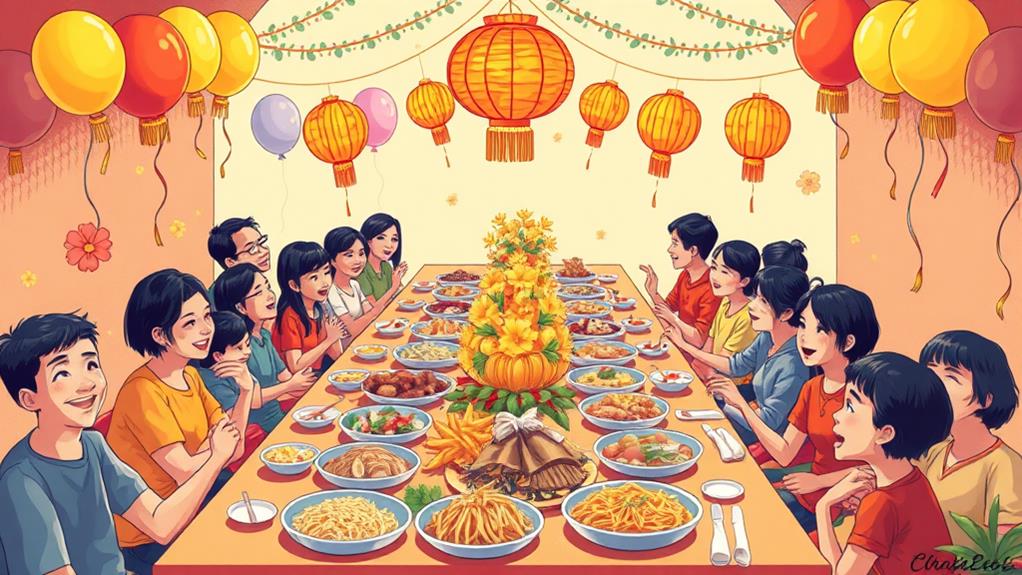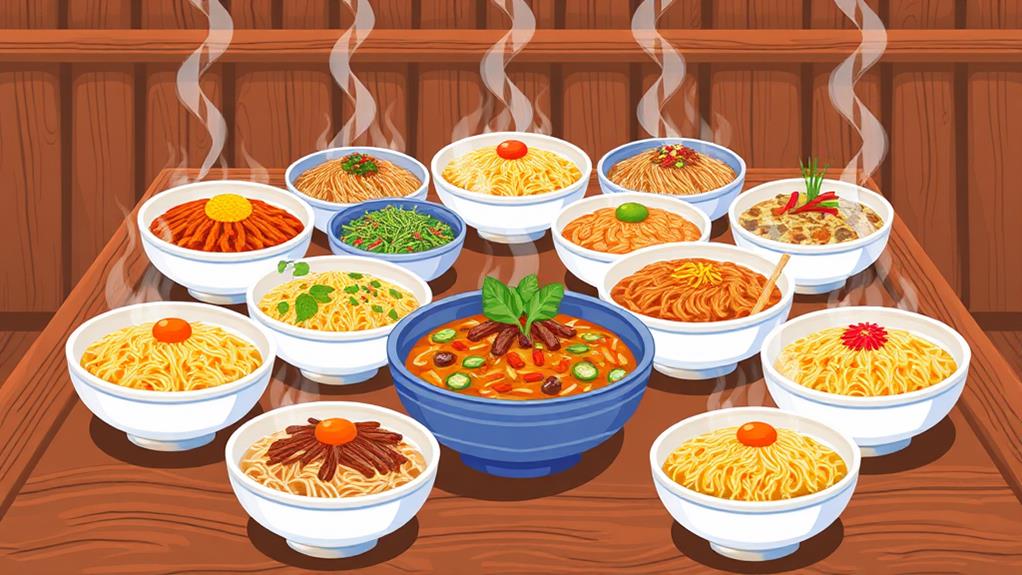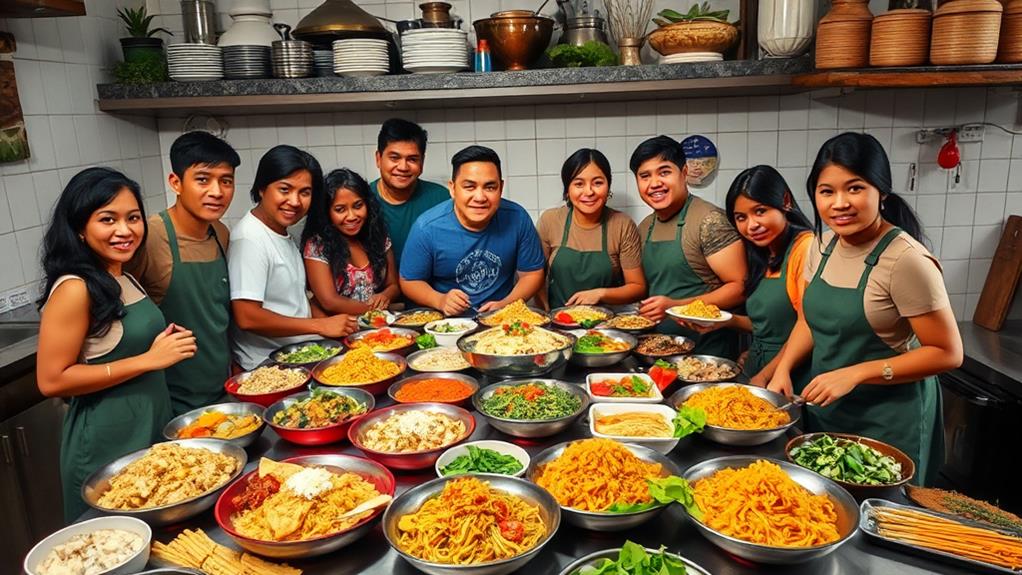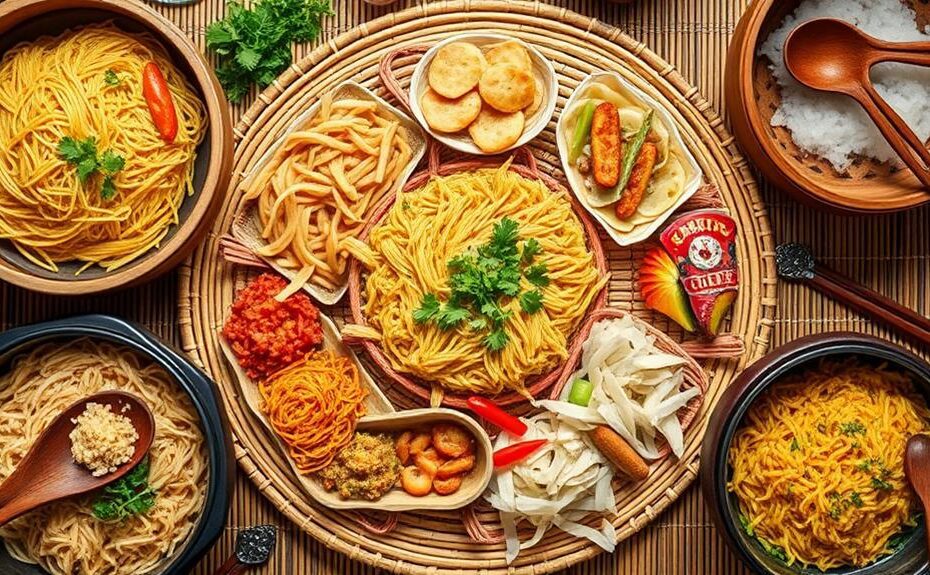Pancit types hold significant cultural importance in Filipino cuisine. Each variation tells a story of fusion, adaptation, and community, reflecting local culinary traditions and unique heritage. For instance, Pancit Canton symbolizes longevity, while Pancit Malabon's vibrant seafood sauce showcases the region's seafood abundance.
Pancit's cultural significance extends beyond the plate. In Filipino culture, it represents prosperity and longevity, bringing people together through shared meals. This cultural importance is evident in the way pancit is often served during special occasions and celebrations.
The diversity of pancit types is a result of cultural exchange and adaptation. As people from different regions and cultures came together, they shared and adapted recipes, resulting in a rich tapestry of pancit variations.
This cultural exchange has preserved heritage and created a unique culinary identity, making pancit an integral part of Filipino culture.
Understanding Pancit's Cultural Roots

Pancit's Cultural Roots
The Origins of Pancit
The term "pancit" comes from the Hokkien Chinese phrase "pian i sit," meaning conveniently cooked food. This name reflects the dish's quick preparation compared to rice.
Introduction to the Philippines
Chinese traders introduced pancit to the Philippines in the 17th century. Since then, it has significantly influenced Filipino culinary culture and practices.
Cultural Significance
Traditionally served during celebrations and special occasions, pancit symbolizes long life and prosperity. This cultural significance is reinforced by the practice of not cutting the noodles during preparation, which emphasizes the importance of longevity associated with the dish.
Enduring Presence in Filipino Culture
This rich culinary heritage is a testament to the pancit dish's enduring presence in Filipino culture. As a staple of Filipino cuisine, pancit isn't only a beloved dish but also a symbol of long life and cultural identity.
Regional Variations of Pancit Types
The Philippines is home to diverse regional variations of pancit types, each offering a unique twist on this beloved Filipino dish.
| Region | Pancit Type | Characteristics |
|---|---|---|
| Pampanga | Pancit Canton | Stir-fried egg noodles with meats and vegetables, symbolizing longevity |
| Malabon City | Pancit Malabon | Thick rice noodles with vibrant orange seafood sauce |
| Various | Pancit Bihon | Thin rice noodles sautéed with meat and vegetables, versatile and commonly served |
| Kapampangan | Pancit Luglug | Thick cornstarch noodles with rich sauce, a favorite in the region |
| Quezon Province | Pancit Habhab | Miki noodles with tangy vinegar dip, served on banana leaves |
Each regional variation offers a distinct flavor profile and cultural significance. The popular Pancit Canton of Pampanga is a staple in many Filipino celebrations. Pancit Malabon is also widely served, while Pancit Luglug and Pancit Habhab showcase regional culinary practices. Pancit Bihon is a versatile dish that can be found in many variations across the country.
Significance in Filipino Celebrations

Pancit's Significance in Filipino Celebrations
Pancit represents longevity and prosperity in Filipino celebrations. This iconic dish is often served during significant events like birthdays, weddings, and New Year festivities, symbolizing long life and good fortune.
Various pancit dishes are featured in restaurants and regional festivals. For instance, Pancit Bihon and Pancit Canton are popular varieties served in restaurants during special events.
Regional festivals showcase unique pancit dishes, highlighting local cultural identity and culinary heritage.
Pancit fosters community bonding in celebrations. It's often served with other Filipino dishes, bringing people together and creating lasting memories.
In birthday celebrations, pancit emphasizes the importance of food in social gatherings.
Evolution of Pancit Through History
Pancit's Origins
Pancit's history dates back to the 18th century, when Chinese immigrants introduced this convenient food to the Philippines.
They integrated their culinary techniques into the local cuisine, resulting in a unique fusion of flavors.
Regional Adaptations
Over the centuries, regional adaptations have shaped pancit into various types, such as Pancit Bihon, Pancit Canton, and Pancit Malabon.
Each type reflects local ingredients and cooking methods, showcasing the cultural exchange between Chinese settlers and Filipino communities.
Cultural Significance
This fusion of culinary traditions has solidified pancit's cultural significance, making it a staple in Filipino celebrations.
Pancit symbolizes long life and prosperity, highlighting the importance of food in Filipino culture.
Evolution and Influence
Pancit's evolution has been influenced by historical exchanges between Chinese and Filipino cultures.
These exchanges have shaped food practices in the Philippines, resulting in a distinct culinary identity.
Notable Pancit Dishes Across Asia

Pancit's Influence Across Asia
Pancit's Chinese roots have led to its spread across Asia, with various regional adaptations emerging.
Philippine Variations
Pancit Bihon and Pancit Canton reflect Chinese culinary traditions in their thin rice noodles and savory sauces.
In contrast, Pancit Palabok's thick rice noodles and vibrant shrimp sauce showcase Malabon's regional flavors and ingredients.
Meanwhile, Pancit Malabon's seafood toppings and bright orange sauce highlight the coastal heritage of the region, emphasizing local ingredients.
Modern adaptations like Pancit Bam-I from Cebu combine different noodle types, demonstrating the diversity in pancit recipes across regions.
Cultural Significance
These regional specialties not only offer unique flavors but also symbolize long life and prosperity, making them staples at Filipino celebrations and gatherings.
Preparation Techniques and Ingredients
Pancit dishes offer a diverse range of flavors, textures, and colors due to the combination of various ingredients and cooking techniques. These noodle dishes utilize different types of noodles, each contributing unique textures and flavors to the meal. For example, some popular noodle types include rice flour noodles, egg noodles, and mung bean noodles.
Common ingredients in pancit preparation include proteins, vegetables, aromatics, and sauces. Proteins like chicken, pork, and seafood are often used, along with vegetables like carrots and bell peppers for added color and nutrition. Aromatics such as garlic and onions are sautéed to create a flavorful base, which is then enhanced by sauces like soy sauce and fish sauce.
Stir-frying and sautéing are common preparation techniques used in pancit dishes. These techniques allow for quick preparation and the melding of flavors. The dish is often garnished with hard-boiled eggs, green onions, or chicharrón for added visual appeal.
Regional ingredients and unique cooking methods can be incorporated into pancit variations, reflecting local culinary traditions and preferences. For instance, Pancit Malabon features vibrant seafood toppings.
Cultural Exchange and Noodle Traditions

Pancit's Cultural Significance
The History of Cultural Exchange: The connection between the Philippines and China has deeply rooted pancit in Filipino culture.
The term "pancit" itself comes from the Hokkien phrase "pian i sit," meaning conveniently cooked, showcasing the impact of Chinese traders and settlers on Filipino cuisine.
Evolution of Pancit Dishes: The cultural exchange has led to the creation of unique pancit dishes, blending Chinese and Filipino culinary traditions.
Regional variations like Pancit Bihon and Pancit Canton demonstrate the adaptability of the dish to local tastes and preferences.
Pancit's Cultural Importance: Pancit plays a significant role in Filipino celebrations, particularly birthdays and festivals, highlighting its cultural significance.
The communal aspect of food is reflected in the presence of pancit at various Filipino gatherings, emphasizing shared cultural heritage and community bonds.
Preserving Heritage Through Cuisine
Filipino cuisine, particularly pancit, is a powerful tool for preserving cultural heritage. Each dish tells a story of the country's rich history and diversity. For instance, the regional variations of pancit reflect the unique heritage of Filipino communities across the archipelago. The adaptation of noodle dishes like pancit illustrates the fusion of culinary traditions, as Filipino cooks incorporate indigenous flavors and methods while honoring their Chinese origins.
Pancit is more than just a delicious meal; it's a cultural tradition that transcends generations.
The tradition of serving pancit on birthdays reflects the cultural belief in the connection between food and well-being, reinforcing communal ties among families and friends. When you pass down family recipes and stories, you're ensuring that culinary heritage is maintained and celebrated through generations.
By embracing pancit, you're preserving a piece of Filipino cultural significance, one delicious and meaningful bite at a time.
How Do Different Types of Pancit Dish Reflect Cultural Traditions in Celebrations?
Different types of pancit dish reflect the cultural significance of pancit dish in various celebrations. In the Philippines, it is a staple in fiestas, birthdays, and other special occasions. From the lengthy “pancit habhab” in Lucban to the savory “pancit malabon” in Malabon City, each variant showcases unique cultural traditions.
Modern Adaptations and Access

Pancit's Adaptation to Modern Lifestyles
As modern lifestyles prioritize convenience and flexibility, pancit has evolved to meet these demands without sacrificing its cultural essence.
Instant noodle versions of popular pancit types are now available in supermarkets, catering to the need for quick meal preparation.
Traditional Pancit Recipes Evolve
Traditional pancit recipes continue to evolve, incorporating contemporary ingredients and cooking techniques while maintaining their cultural roots.
This fusion of old and new allows pancit to stay relevant in modern times.
Access Points for Modern Consumers
Pancit is now more accessible than ever, with regional pancit variations promoted through local food markets and online platforms.
Food blogs and social media share modern pancit recipes that appeal to health-conscious consumers and global audiences.
Pancit's Enduring Significance
Pancit remains a popular choice for casual and festive gatherings, reflecting its enduring significance in Filipino culinary traditions.
Its adaptability has ensured its continued relevance in modern Filipino culture.
Frequently Asked Questions
What Is the Cultural Significance of Pancit?
Pancit is more than just a dish; it represents longevity, prosperity, and unity in Filipino culture. This significance is reflected in the various pancit variations, which have been shaped by historical influences and regional differences.
The fusion of Chinese and Filipino culinary practices has resulted in a unique blend of flavors and traditions. For example, the use of noodles, a staple in Chinese cuisine, has been adapted into Filipino cooking.
Local ingredients, such as vegetables and spices, have been incorporated to create distinct pancit types, each telling a story of cultural exchange and evolution.
Pancit has become a staple that embodies the heart of Filipino identity, representing the country's rich cultural heritage.
What Is the Significance of Noodles in Chinese Culture?
Noodles hold significant cultural importance in China, symbolizing longevity and long life. This symbolism is rooted in the belief that the length of noodles represents a long and healthy life.
Different regions in China have their own unique noodle styles, showcasing local traditions and culinary heritage. For example, the north is famous for its hand-pulled lamian noodles, while the south is known for its thin, delicate rice noodles.
During the Lunar New Year, noodles play a central role in celebrations, promoting prosperity and good fortune. The traditional saying "long noodles, long life" emphasizes the significance of noodles in conveying blessings and cultural values.
What Is the Filipino Noodle Tradition?
Filipino noodles hold significant cultural importance, particularly during festive occasions where they symbolize long life and prosperity.
Regional variations of pancit showcase local flavors and cooking styles. For instance, the delicate strands of Pancit Bihon differ from the heartier noodles of Pancit Canton.
These distinctions highlight the country's diverse heritage and cultural nuances.
Each region's unique take on pancit contributes to the rich tapestry of the Filipino noodle tradition. By exploring these variations, one can uncover the intricate cultural significance that makes Filipino noodles an integral part of the country's identity.
What Is the Story Behind Pancit Canton?
Pancit Canton originated from Chinese lo mein. This Filipino stir-fry noodle dish was brought to the Philippines by Chinese migrants and has since evolved into a distinct culinary identity.
The cooking technique is crucial in making Pancit Canton. It requires a sizzling wok to quickly stir-fry the noodles and vegetables, resulting in a harmonious balance of flavors.
The key to achieving this balance lies in the combination of soy sauce and vegetables. For instance, adding vegetables like cabbage, carrots, and bean sprouts creates a crunchy texture, while soy sauce enhances the overall flavor.
The evolution of Pancit Canton reflects the Philippines' complex cultural heritage. The Chinese migrants who introduced lo mein to the Philippines adapted it to local tastes, incorporating regional ingredients and cooking techniques.
Over time, regional variations of Pancit Canton emerged. For example, some recipes add protein sources like pork or shrimp, while others use different types of noodles or spices.
